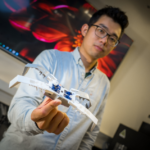News, New Flexoskeletons Could Help Create New Class of Soft, Bioinspired Robots
A new technique developed by engineers from the University of California San Diego avoids the need for any exclusive equipment and creates flexible, soft, 3D-printed robots in just minutes. The invention arises from re-evaluating how soft robots are developed: rather than finding out how to add soft materials to a rigid robot body, researchers at UC San Diego began working with a soft body and added rigid features to main components. Since the structures were inspired by the exoskeletons of insects—that include both soft and rigid parts—the researchers named their robots “flexoskeletons.” The new technique enables developing soft components for robots in a fraction of the time earlier required and for only a fraction of the cost.
Learn about our two Decals!
 Click here to find out more about our Fall Bioinspired Design Decal and our Spring Bioinspired Design in Action Decal – ALL MAJORS are welcome.
Click here to find out more about our Fall Bioinspired Design Decal and our Spring Bioinspired Design in Action Decal – ALL MAJORS are welcome.Berkeley BioDesign Community
 Click here to learn about the BioD: Bio-Inspired Design @ Berkeley student organization or here to signup for more info.
Click here to learn about the BioD: Bio-Inspired Design @ Berkeley student organization or here to signup for more info.Search
Student Login




I imagine that the neurological circuits underlying these processes are governed by both 2d spacing maps with their brains as…
to reduce the impact of car accidents, it may be possible to study the force diverting physics of cockroaches to…
you see this type of head-bobbing stability in many avian creatures related to pigeons like chickens. the head ability to…
not like they taught horses how to run! this is an example of convergent evolution where both sea creatures and…
The brain functions in a similar way with neuronal connections. our brains are able to utilize the multiplicity of connections…